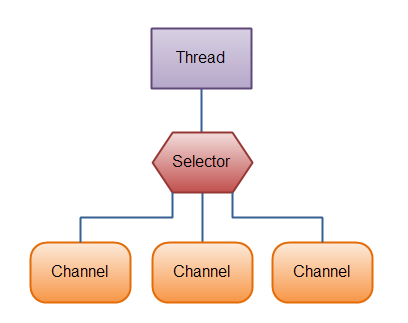Selector
Selector 允许一个单一的线程来操作多个 Channel. 如果我们的应用程序中使用了多个 Channel, 那么使用 Selector 很方便的实现这样的目的, 但是因为在一个线程中使用了多个 Channel, 因此也会造成了每个 Channel 传输效率的降低.
使用 Selector 的图解如下:
为了使用 Selector, 我们首先需要将 Channel 注册到 Selector 中, 随后调用 Selector 的 select()方法, 这个方法会阻塞, 直到注册在 Selector 中的 Channel 发送可读写事件. 当这个方法返回后, 当前的这个线程就可以处理 Channel 的事件了.
创建选择器
通过 Selector.open()方法, 我们可以创建一个选择器:
Selector selector = Selector.open();将 Channel 注册到选择器中
为了使用选择器管理 Channel, 我们需要将 Channel 注册到选择器中:
channel.configureBlocking(false);
SelectionKey key = channel.register(selector, SelectionKey.OP_READ);
注意, 如果一个 Channel 要注册到 Selector 中, 那么这个 Channel 必须是非阻塞的, 即channel.configureBlocking(false);
因为 Channel 必须要是非阻塞的, 因此 FileChannel 是不能够使用选择器的, 因为 FileChannel 都是阻塞的.
注意到, 在使用 Channel.register()方法时, 第二个参数指定了我们对 Channel 的什么类型的事件感兴趣, 这些事件有:
Connect, 即连接事件(TCP 连接), 对应于SelectionKey.OP_CONNECT
Accept, 即确认事件, 对应于SelectionKey.OP_ACCEPT
Read, 即读事件, 对应于SelectionKey.OP_READ, 表示 buffer 可读.
Write, 即写事件, 对应于SelectionKey.OP_WRITE, 表示 buffer 可写.
一个 Channel发出一个事件也可以称为 对于某个事件, Channel 准备好了. 因此一个 Channel 成功连接到了另一个服务器也可以被称为 connect ready.
我们可以使用或运算|来组合多个事件, 例如:
int interestSet = SelectionKey.OP_READ | SelectionKey.OP_WRITE; 注意, 一个 Channel 仅仅可以被注册到一个 Selector 一次, 如果将 Channel 注册到 Selector 多次, 那么其实就是相当于更新 SelectionKey 的 interest set. 例如:
channel.register(selector, SelectionKey.OP_READ);
channel.register(selector, SelectionKey.OP_READ | SelectionKey.OP_WRITE);上面的 channel 注册到同一个 Selector 两次了, 那么第二次的注册其实就是相当于更新这个 Channel 的 interest set 为 SelectionKey.OP_READ | SelectionKey.OP_WRITE.
关于 SelectionKey
如上所示, 当我们使用 register 注册一个 Channel 时, 会返回一个 SelectionKey 对象, 这个对象包含了如下内容:
interest set, 即我们感兴趣的事件集, 即在调用 register 注册 channel 时所设置的 interest set.
ready set
channel
selector
attached object, 可选的附加对象
interest set
我们可以通过如下方式获取 interest set:
int interestSet = selectionKey.interestOps();
boolean isInterestedInAccept = interestSet & SelectionKey.OP_ACCEPT;
boolean isInterestedInConnect = interestSet & SelectionKey.OP_CONNECT;
boolean isInterestedInRead = interestSet & SelectionKey.OP_READ;
boolean isInterestedInWrite = interestSet & SelectionKey.OP_WRITE; ready set
代表了 Channel 所准备好了的操作.
我们可以像判断 interest set 一样操作 Ready set, 但是我们还可以使用如下方法进行判断:
int readySet = selectionKey.readyOps();
selectionKey.isAcceptable();
selectionKey.isConnectable();
selectionKey.isReadable();
selectionKey.isWritable();Channel 和 Selector
我们可以通过 SelectionKey 获取相对应的 Channel 和 Selector:
Channel channel = selectionKey.channel();
Selector selector = selectionKey.selector(); Attaching Object
我们可以在selectionKey中附加一个对象:
selectionKey.attach(theObject);
Object attachedObj = selectionKey.attachment();或者在注册时直接附加:
SelectionKey key = channel.register(selector, SelectionKey.OP_READ, theObject);通过 Selector 选择 Channel
我们可以通过 Selector.select()方法获取对某件事件准备好了的 Channel, 即如果我们在注册 Channel 时, 对其的可写事件感兴趣, 那么当 select()返回时, 我们就可以获取 Channel 了.
注意, select()方法返回的值表示有多少个 Channel 可操作.
获取可操作的 Channel
如果 select()方法返回值表示有多个 Channel 准备好了, 那么我们可以通过 Selected key set 访问这个 Channel:
Set<SelectionKey> selectedKeys = selector.selectedKeys();
Iterator<SelectionKey> keyIterator = selectedKeys.iterator();
while(keyIterator.hasNext()) {
SelectionKey key = keyIterator.next();
if(key.isAcceptable()) {
// a connection was accepted by a ServerSocketChannel.
} else if (key.isConnectable()) {
// a connection was established with a remote server.
} else if (key.isReadable()) {
// a channel is ready for reading
} else if (key.isWritable()) {
// a channel is ready for writing
}
keyIterator.remove();
}注意, 在每次迭代时, 我们都调用 "keyIterator.remove()" 将这个 key 从迭代器中删除, 因为 select() 方法仅仅是简单地将就绪的 IO 操作放到 selectedKeys 集合中, 因此如果我们从 selectedKeys 获取到一个 key, 但是没有将它删除, 那么下一次 select 时, 这个 key 所对应的 IO 事件还在 selectedKeys 中.
例如此时我们收到 OP_ACCEPT 通知, 然后我们进行相关处理, 但是并没有将这个 Key 从 SelectedKeys 中删除, 那么下一次 select() 返回时 我们还可以在 SelectedKeys 中获取到 OP_ACCEPT 的 key.注意, 我们可以动态更改 SekectedKeys 中的 key 的 interest set. 例如在 OP_ACCEPT 中, 我们可以将 interest set 更新为 OP_READ, 这样 Selector 就会将这个 Channel 的 读 IO 就绪事件包含进来了.
Selector 的基本使用流程
通过 Selector.open() 打开一个 Selector.
将 Channel 注册到 Selector 中, 并设置需要监听的事件(interest set)
-
不断重复:
调用 select() 方法
调用 selector.selectedKeys() 获取 selected keys
-
迭代每个 selected key:
*从 selected key 中获取 对应的 Channel 和附加信息(如果有的话)
*判断是哪些 IO 事件已经就绪了, 然后处理它们.
如果是 OP_ACCEPT 事件, 则调用 "SocketChannel clientChannel = ((ServerSocketChannel) key.channel()).accept()" 获取 SocketChannel, 并将它设置为 非阻塞的, 然后将这个 Channel 注册到 Selector 中.*根据需要更改 selected key 的监听事件.
*将已经处理过的 key 从 selected keys 集合中删除.
关闭 Selector
当调用了 Selector.close()方法时, 我们其实是关闭了 Selector 本身并且将所有的 SelectionKey 失效, 但是并不会关闭 Channel.
完整的 Selector 例子
public class NioEchoServer {
private static final int BUF_SIZE = 256;
private static final int TIMEOUT = 3000;
public static void main(String args[]) throws Exception {
// 打开服务端 Socket
ServerSocketChannel serverSocketChannel = ServerSocketChannel.open();
// 打开 Selector
Selector selector = Selector.open();
// 服务端 Socket 监听8080端口, 并配置为非阻塞模式
serverSocketChannel.socket().bind(new InetSocketAddress(8080));
serverSocketChannel.configureBlocking(false);
// 将 channel 注册到 selector 中.
// 通常我们都是先注册一个 OP_ACCEPT 事件, 然后在 OP_ACCEPT 到来时, 再将这个 Channel 的 OP_READ
// 注册到 Selector 中.
serverSocketChannel.register(selector, SelectionKey.OP_ACCEPT);
while (true) {
// 通过调用 select 方法, 阻塞地等待 channel I/O 可操作
if (selector.select(TIMEOUT) == 0) {
System.out.print(".");
continue;
}
// 获取 I/O 操作就绪的 SelectionKey, 通过 SelectionKey 可以知道哪些 Channel 的哪类 I/O 操作已经就绪.
Iterator<SelectionKey> keyIterator = selector.selectedKeys().iterator();
while (keyIterator.hasNext()) {
SelectionKey key = keyIterator.next();
// 当获取一个 SelectionKey 后, 就要将它删除, 表示我们已经对这个 IO 事件进行了处理.
keyIterator.remove();
if (key.isAcceptable()) {
// 当 OP_ACCEPT 事件到来时, 我们就有从 ServerSocketChannel 中获取一个 SocketChannel,
// 代表客户端的连接
// 注意, 在 OP_ACCEPT 事件中, 从 key.channel() 返回的 Channel 是 ServerSocketChannel.
// 而在 OP_WRITE 和 OP_READ 中, 从 key.channel() 返回的是 SocketChannel.
SocketChannel clientChannel = ((ServerSocketChannel) key.channel()).accept();
clientChannel.configureBlocking(false);
//在 OP_ACCEPT 到来时, 再将这个 Channel 的 OP_READ 注册到 Selector 中.
// 注意, 这里我们如果没有设置 OP_READ 的话, 即 interest set 仍然是 OP_CONNECT 的话, 那么 select 方法会一直直接返回.
clientChannel.register(key.selector(), OP_READ, ByteBuffer.allocate(BUF_SIZE));
}
if (key.isReadable()) {
SocketChannel clientChannel = (SocketChannel) key.channel();
ByteBuffer buf = (ByteBuffer) key.attachment();
long bytesRead = clientChannel.read(buf);
if (bytesRead == -1) {
clientChannel.close();
} else if (bytesRead > 0) {
key.interestOps(OP_READ | SelectionKey.OP_WRITE);
System.out.println("Get data length: " + bytesRead);
}
}
if (key.isValid() && key.isWritable()) {
ByteBuffer buf = (ByteBuffer) key.attachment();
buf.flip();
SocketChannel clientChannel = (SocketChannel) key.channel();
clientChannel.write(buf);
if (!buf.hasRemaining()) {
key.interestOps(OP_READ);
}
buf.compact();
}
}
}
}
}本文由 yongshun 发表于个人博客, 采用署名-非商业性使用-相同方式共享 3.0 中国大陆许可协议.
非商业转载请注明作者及出处. 商业转载请联系作者本人
Email: yongshun1228@gmail .com
本文标题为: Java NIO 的前生今世 之四 NIO Selector 详解
本文链接为: segmentfault.com/a/1190000006824196

**粗体** _斜体_ [链接](http://example.com) `代码` - 列表 > 引用。你还可以使用@来通知其他用户。